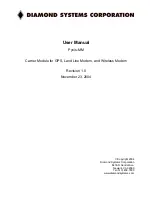
Motus Reference Manual
Page 42 of 146
Version 1.1
29/11/2019
11.3
Time
Motus was designed to provide a highly accurate time reference. When a GNSS fix is
available Motus's time is accurate to within 50 nanoseconds. When a GNSS fix is lost,
Motus's time accuracy typically remains within 10 microseconds over extended time
periods. When Motus hot starts the time accuracy is typically within 1 second
immediately on startup and corrected to within 50 nanoseconds as soon as a GNSS fix
is achieved and 1PPS received. To synchronise with Motus's high accuracy time, both
the packet protocol and a 1PPS line must be used.
11.4
Heading Source
There are three different heading sources available for Motus. By default Motus uses
both magnetic heading and velocity heading. It is possible to use multiple heading
sources and this will often provide performance benefits.
11.4.1
Magnetic Heading
This is the default heading source and works well in the majority of cases. When using
magnetic heading, calibration is required every time Motus's installation changes. The
downside of magnetic heading is that prolonged dynamic magnetic interference
sources can cause heading errors.
11.4.2
Velocity Heading
Velocity heading works by deriving heading from the direction of velocity and
acceleration. Velocity heading works well with cars, boats, fixed wing aircraft and other
vehicles that don't move sideways. Velocity heading does not work with helicopters
and other 3D vehicles. The downside of velocity heading is that heading can not be
measured until the vehicle moves at a horizontal speed of over 1.15 metres/second
with a GNSS fix. The benefits of velocity heading are that it is immune to magnetic
interference and no calibration is required when Motus's installation changes.
11.4.3
External Heading
External heading can be used if there is some other way to derive heading that is
external to Motus. Examples include dual antenna GNSS systems, gyro-compasses,
reference markers and SLAM systems. The heading must be fed into Motus using the
External Heading Packet or through NMEA into a GPIO pin.
11.5
Magnetics
Static magnetic interference is defined as anything that provides a fixed vector of
magnetic interference to Motus, an example would be the steel body of a car that
Motus is mounted on. Dynamic magnetic interference is defined as anything that
provides varying magnetic interference, an example would be when Motus is mounted
on an engine and the pistons within are moving relative to Motus and providing a
changing magnetic field.
Static magnetic interference is resolved through magnetic calibration and dynamic
magnetic interference is compensated by a filter algorithm but should be minimised
















































